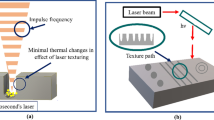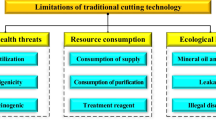Abstract
CHEMICAL effects in boundary lubrication have been the subject of a considerable amount of investigation. In the case of aluminium, Shaw1 attempted to relate the reactivity observed on immersion of aluminium disks in boiling organic liquids to the lubricating ability of these liquids when they were used as cutting fluids. Tingle2 measured the coefficient of friction of surfaces which had been shaved under various chemicals, and, on the basis of the coefficient, ascribed an order of reactivity. Neither method succeeded in unambiguously relating the surface chemistry to lubrication chemistry.
Similar content being viewed by others
References
Shaw, M. C., Ann. N.Y. Acad. Sci., 53, 962 (1951).
Tingle, E. D., Nature, 160, 710 (1947).
Whitehead, J. R., Proc. Roy. Soc., A, 201, 109 (1950).
Klint, R. V., and Owens, R. S., A.S.L.E., Trans., 5, 32 (1962).
Author information
Authors and Affiliations
Rights and permissions
About this article
Cite this article
PIERRE, L., OWENS, R. & KLINT, R. Chemical Effects in the Boundary Lubrication of Aluminium. Nature 202, 1204–1205 (1964). https://doi.org/10.1038/2021204a0
Issue Date:
DOI: https://doi.org/10.1038/2021204a0
- Springer Nature Limited
This article is cited by
-
Towards eliminating friction and wear in plain bearings operating without lubrication
Scientific Reports (2023)
-
Effect of Adsorbed Olefines on the Oxidation of Aluminium Films
Nature (1965)





